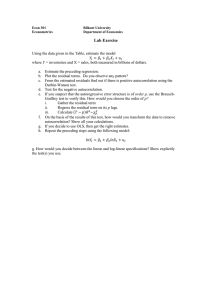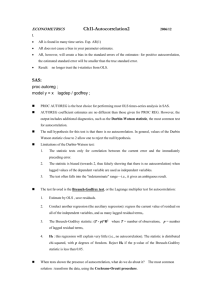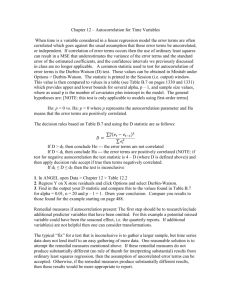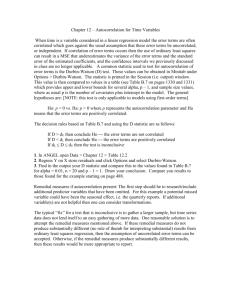AUTOCORRELATION
advertisement
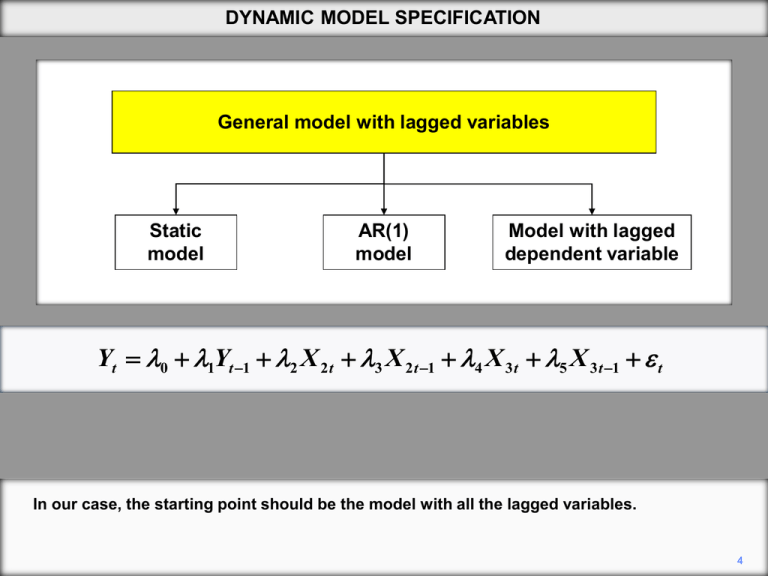
DYNAMIC MODEL SPECIFICATION General model with lagged variables Static model AR(1) model Model with lagged dependent variable Yt 0 1Yt 1 2 X 2 t 3 X 2 t 1 4 X 3 t 5 X 3 t 1 t In our case, the starting point should be the model with all the lagged variables. 4 DYNAMIC MODEL SPECIFICATION General model with lagged variables Static model AR(1) model Model with lagged dependent variable Yt 0 1Yt 1 2 X 2 t 3 X 2 t 1 4 X 3 t 5 X 3 t 1 t 1 3 5 0 Having fitted it, we might be able to simplify it to the static model, if the lagged variables individually and as a group do not have significant explanatory power. 5 DYNAMIC MODEL SPECIFICATION General model with lagged variables Static model AR(1) model Model with lagged dependent variable Yt 0 1Yt 1 2 X 2 t 3 X 2 t 1 4 X 3 t 5 X 3 t 1 t 3 12 5 14 If the lagged variables do have significant explanatory power, we could perform a common factor test and see if we could simplify the model to an AR(1) specification. 6 DYNAMIC MODEL SPECIFICATION General model with lagged variables Static model AR(1) model Model with lagged dependent variable Yt 0 1Yt 1 2 X 2 t 3 X 2 t 1 4 X 3 t 5 X 3 t 1 t 3 5 0 Sometimes we may find that a model with a lagged dependent variable is an adequate dynamic specification, if the other lagged variables lack significant explanatory power. 7 DYNAMIC MODEL SPECIFICATION Model with lagged variables AR(p) DL(q) ADL(p,q) In our case, the starting point should be the model with all the lagged variables. 4 DYNAMIC MODEL SPECIFICATION General model with lagged variables AR(p) DL(q) ADL(p,q) Yt 0 1Yt 1 ... pYt p t The model includes lags of the explained variable. 5 DYNAMIC MODEL SPECIFICATION General model with lagged variables AR(p) DL(q) ADL(p,q) Yt 0 0 X t 1 X t 1 2 X t 2 ... q X t q t The model includes lags of the independent variable. 6 DYNAMIC MODEL SPECIFICATION General model with lagged variables AR(p) DL(q) ADL(p,q) Yt 0 1Yt 1 ... pYt p 0 X t 1 X t 1 ... q X t q t The model includes lags of the dependent and independent variables. 7 AUTOCORRELATION Y 1 X In the graph above, positive values tend to be followed by positive ones, and negative values by negative ones. Successive values tend to have the same sign. This is described as positive autocorrelation. 2 AUTOCORRELATION Y 1 X In this graph, positive values tend to be followed by negative ones, and negative values by positive ones. This is an example of negative autocorrelation. 3 AUTOCORRELATION Yt 1 2 X t ut First-order autoregressive autocorrelation: AR(1) ut ut 1 t A particularly common type of autocorrelation, at least as an approximation, is first-order autoregressive autocorrelation, usually denoted AR(1) autocorrelation. 8 AUTOCORRELATION Yt 1 2 X t ut First-order autoregressive autocorrelation: AR(1) ut ut 1 t Fifth-order autoregressive autocorrelation: AR(5) ut 1ut 1 2 ut 2 3 ut 3 4 ut 4 5 ut 5 t Here is a more complex example of autoregressive autocorrelation. It is described as fifthorder, and so denoted AR(5), because it depends on lagged values of ut up to the fifth lag. 8 AUTOCORRELATION Yt 1 2 X t ut First-order autoregressive autocorrelation: AR(1) ut ut 1 t Fifth-order autoregressive autocorrelation: AR(5) ut 1ut 1 2 ut 2 3 ut 3 4 ut 4 5 ut 5 t Third-order moving average autocorrelation: MA(3) ut 0 t 1 t 1 2 t 2 3 t 3 The other main type of autocorrelation is moving average autocorrelation, where the disturbance term is a linear combination of the current innovation and a finite number of previous ones. 8 AUTOCORRELATION Yt 1 2 X t ut First-order autoregressive autocorrelation: AR(1) ut ut 1 t Fifth-order autoregressive autocorrelation: AR(5) ut 1ut 1 2 ut 2 3 ut 3 4 ut 4 5 ut 5 t Third-order moving average autocorrelation: MA(3) ut 0 t 1 t 1 2 t 2 3 t 3 This example is described as third-order moving average autocorrelation, denoted MA(3), because it depends on the three previous innovations as well as the current one. 8 AUTOCORRELATION ut ut 1 t 3 2 1 0 1 -1 -2 -3 We will now look at examples of the patterns that are generated when the disturbance term is subject to AR(1) autocorrelation. The object is to provide some bench-mark images to help you assess plots of residuals in time series regressions. 9 AUTOCORRELATION ut ut 1 t 3 2 1 0 1 -1 -2 -3 We will use 50 independent values of , taken from a normal distribution with 0 mean, and generate series for u using different values of . 10 AUTOCORRELATION ut 0.0ut 1 t 3 2 1 0 1 -1 -2 -3 We have started with equal to 0, so there is no autocorrelation. We will increase progressively in steps of 0.1. 11 AUTOCORRELATION ut 0.1ut 1 t 3 2 1 0 1 -1 -2 -3 ( = 0.1) 12 AUTOCORRELATION ut 0.2ut 1 t 3 2 1 0 1 -1 -2 -3 ( = 0.2) 13 AUTOCORRELATION ut 0.3ut 1 t 3 2 1 0 1 -1 -2 -3 With equal to 0.3, a pattern of positive autocorrelation is beginning to be apparent. 14 AUTOCORRELATION ut 0.4ut 1 t 3 2 1 0 1 -1 -2 -3 ( = 0.4) 15 AUTOCORRELATION ut 0.5ut 1 t 3 2 1 0 1 -1 -2 -3 ( = 0.5) 16 AUTOCORRELATION ut 0.6ut 1 t 3 2 1 0 1 -1 -2 -3 With equal to 0.6, it is obvious that u is subject to positive autocorrelation. Positive values tend to be followed by positive ones and negative values by negative ones. 17 AUTOCORRELATION ut 0.7ut 1 t 3 2 1 0 1 -1 -2 -3 ( = 0.7) 18 AUTOCORRELATION ut 0.8ut 1 t 3 2 1 0 1 -1 -2 -3 ( = 0.8) 19 AUTOCORRELATION ut 0.9ut 1 t 3 2 1 0 1 -1 -2 -3 With equal to 0.9, the sequences of values with the same sign have become long and the tendency to return to 0 has become weak. 20 AUTOCORRELATION ut 0.95ut 1 t 3 2 1 0 1 -1 -2 -3 The process is now approaching what is known as a random walk, where is equal to 1 and the process becomes nonstationary. The terms ‘random walk’ and ‘nonstationary’ will be defined in the next chapter. For the time being we will assume | | < 1. 21 AUTOCORRELATION ut 0.0ut 1 t 3 2 1 0 1 -1 -2 -3 Next we will look at negative autocorrelation, starting with the same set of 50 independently distributed values of t. 22 AUTOCORRELATION ut 0.3ut 1 t 3 2 1 0 1 -1 -2 -3 We will take larger steps this time. 23 AUTOCORRELATION ut 0.6ut 1 t 3 2 1 0 1 -1 -2 -3 With equal to –0.6, you can see that positive values tend to be followed by negative ones, and vice versa, more frequently than you would expect as a matter of chance. 24 AUTOCORRELATION ut 0.9ut 1 t 3 2 1 0 1 -1 -2 -3 Now the pattern of negative autocorrelation is very obvious. 25 TESTS FOR AUTOCORRELATION I: BREUSCH–GODFREY TEST Breusch–Godfrey test k Yt 1 j X jt ut j 2 k q j2 s 1 et 1 j X jt s et s Test statistic: nR2, distributed as c2(q) Under the null hypothesis of no autocorrelation, nR2 has a chi-squared distribution with q degrees of freedom. 20 Copyright Christopher Dougherty 2013 These slideshows may be downloaded by anyone, anywhere for personal use. Subject to respect for copyright and, where appropriate, attribution, they may be used as a resource for teaching an econometrics course. There is no need to refer to the author. The content of this slideshow comes from Section 12.1 of C. Dougherty, Introduction to Econometrics, fourth edition 2011, Oxford University Press. Additional (free) resources for both students and instructors may be downloaded from the OUP Online Resource Centre http://www.oup.com/uk/orc/bin/9780199567089/. Individuals studying econometrics on their own who feel that they might benefit from participation in a formal course should consider the London School of Economics summer school course EC212 Introduction to Econometrics http://www2.lse.ac.uk/study/summerSchools/summerSchool/Home.aspx or the University of London International Programmes distance learning course 20 Elements of Econometrics www.londoninternational.ac.uk/lse. 2013.03.04


